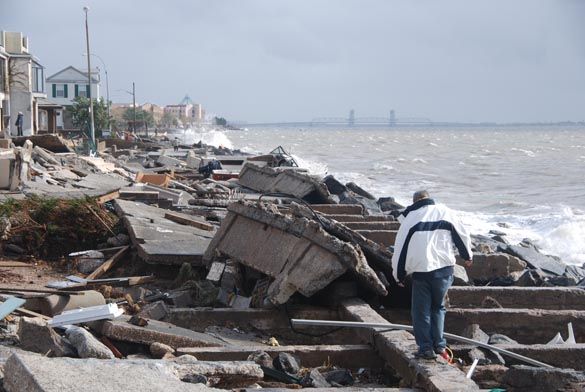Manhattan Beach Residents Frustrated After Meeting With FEMA

Residents of Manhattan Beach were left with more questions than answers after a meeting last night with a FEMA spokesperson that was meant to help people understand the mystifying world of federal disaster aid. The meeting was held by the Manhattan Beach Community Group where residents were invited to question FEMA about the recovery process and new programs to aid Superstorm Sandy victims.
“We keep trying to get someone [from FEMA] who can answer our questions,” said Bernice Fleischer, vice president of the community group. “And I’m afraid tonight was less than satisfactory.”
FEMA agent Corinne Azrak, who deals with external affairs for the agency, came to the meeting in an attempt to answer questions people had about Superstorm Sandy aid. But she prefaced her answers by explaining the limitations of FEMA.
“We’re a disaster response agency. Our job is to get the community back to the way it was before it got hit,” Azrak said. So they can’t do things like build a levy, yet most attendees were concerned with such preventative issues.
This wasn’t the first time that the MBCG invited a representative from a disaster aid program. Last month a member from NY Rising, a state program that funnels money to local communities for resiliency and recovery effots, became the object of frustration because of how slow moving the process was taking.
One member of the community asked if FEMA could give the city and state government advice since they were the ones on the ground witnessing the damages. One example was given about the construction that was done on Manhattan Beach’s esplanade to raise it by four feet. Other members piped in and said that they thought it was dangerous to have such a high esplanade because if another storm like Sandy hits, the concrete might be dislodged and move inshore where it could become a hazard.
“It’s a city issue,” Azrak said. “We can’t tell the city how to run the emergency plans.”
But on the subject of FEMA meeting with different entitie,s like the Army Corps of Engineers, and members of the city government, Azrak said, “I’m sure they have those high level meetings somewhere. I’ve just never been privy to them.”
Community members soon discovered what Azrak meant when she prefaced her talk by explaining the limitations of FEMA. With most issues that were asked, Azrak responded that it was some other entity’s responsibility.
But one question Azrak was able to answer was about how FEMA decides on the amount of money individual homes receive. One community member asked why is it that two neighboring houses that have seemingly identical damages can receive very different amounts of aid money.
“It is a case by case basis,” Azrak explained. So while the damages may seem identical, there might be a problem with one house’s boiler while the neighboring house’s boiler remained unscathed.
Another reason for disparities in aid is because FEMA only pays to repair “habitable areas.” If a house has two bedrooms but only one of the bedrooms is in use, they won’t pay for the vacant room.
The person who asked the question wasn’t satisfied with this response.
“It all seems to be very subjective and arbitrary,” he said.
Many members were also worried about the mandatory flood insurance requirements, slated for 2015 when the new flood maps will take effect.
One man said that FEMA had given him a quote that would have given him more money than his own private insurance.
“It seems to me that your agency will pay me more than my insurance,” he said. “What seems to be the reality is my taxes will go up. My mortgage will go up but aid” from his insurance will go down.
Fleischer, the vice-president, thanked Azrak for coming, but noted, “This is a very frustrated community.”
Members of Manhattan Beach Community Group weren’t the only ones frustrated by FEMA’s lackluster response at local meetings. During a Marine Park Civic Association meeting last week, attendees became frustrated with the FEMA representative that had come to that meeting to answer questions. The group’s president, Jim Ivaliotis, wrote an apology to group members in their latest newsletter.
“It seems FEMA left us with more questions than answers,” he wrote. “Despite our coordinated efforts with them, things did not go as planned.”




